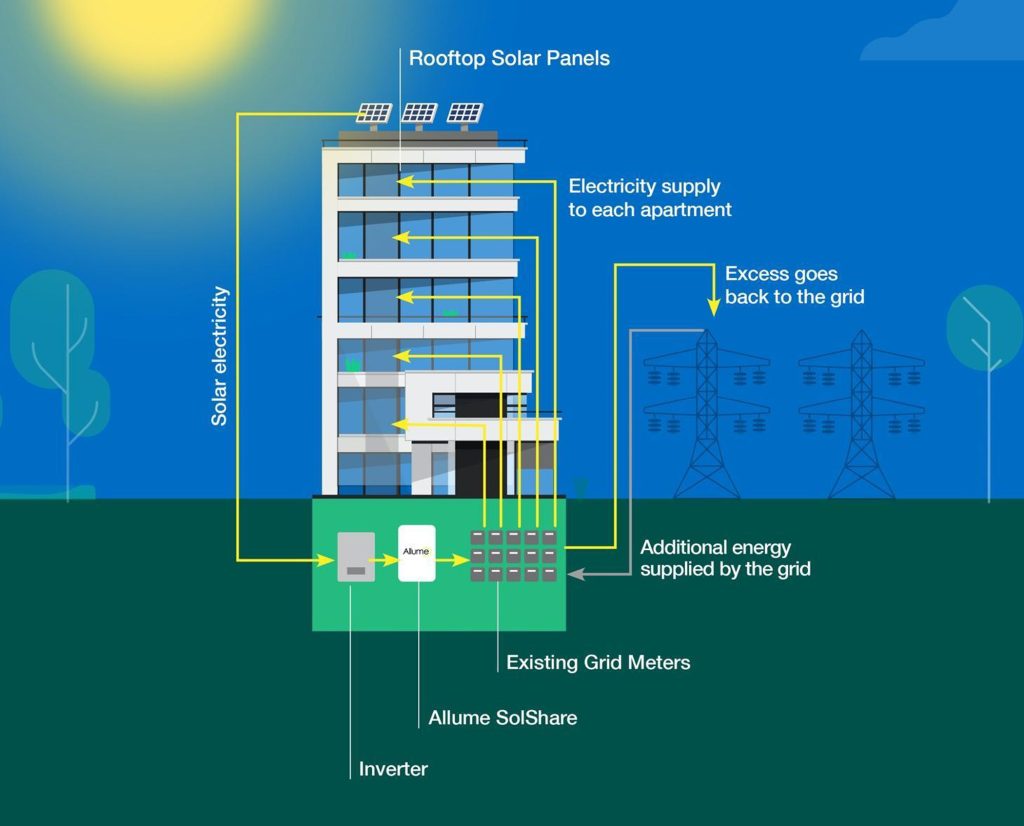At Christie Walk our overall Strata Corporation is considering adding additional solar PV and batteries to reduce our energy imports from the grid. But this will be much more useful if we can share the generated energy across multiple dwellings instead of exporting excess PV generation to the grid.
We mentioned the Solshare device by Allume Energy as an option in our 2022 planning document Episode 11 – Innovative solar, storage and sharing.
Early history of Solshare
In 1999 Allume won a $220,000 grant from ARENA towards an ambitious demonstration project that was designed to install 487kW of rooftop solar across 10 multi-unit Salvation Army properties in Tasmania. Solshare technology would enable the energy produced by a single solar system to be distributed to separately metered units, such as those in apartments and commercial buildings.
Unfortunately the project ran into a range of technical and logistical problems and was terminated early due to “an inability to scale”.
Subsequent successful installations
Much was learnt in the ARENA demonstration project, and subsequently Solshare has been successfully deployed in a range of strata settings such as:
- 3 apartments in Neutral Bay, NSW
- This introductory guide from Allume Energy includes a summary of technical requirements as well as a case study of a Solshare installation at Mirvac’s Folia Apartments of Tullamore in Doncaster, Vic. The system distributes 70kW of solar to 39 apartments.
How Solshare works
On the Allume Energy website there’s a detailed description of how Solshare works and why it is needed. The easiest way to understand it is visually for a typical apartment block installation:

In a typical retrofit situation – such as we have at Christie Walk – a key feature is that each of the participating residential owners keep their existing connection to the grid, and can continue to choose their own energy retailer. This is good from the point of view of redundancy so that a failure at the PV inverter or Solshare does not leave residences without power.
But it also means that Solshare does not resolve one of our goals at Christie Walk which was to eliminate some of our 17 connections to the grid, each of which is billed the daily supply fee. Those daily charges add up to over $4,000 for our site, money we could better use for upgrades!
Considerations when planning a Solshare installation
The diagram above makes Solshare easy to understand in general, but it’s also easy to miss some of the implications that need to be taken into account when planning an installation.
- Unlike a normal PV installation, the solar inverter is not connected to the grid. This has several implications:
- You can install a battery between the solar inverter and the Solshare device to allow time-shifting of some of your generated solar energy to evening and morning peak use.
- However, Solshare can only send solar energy in one direction: from PV into the Solshare. Therefore with Solshare you cannot buy cheap off-peak from the grid to top-up the battery in the way that is possible for a fully behind-the-meter apartment block solution such as our Sturt Apartments building at Christie Walk.
- All of the dwelling NMI / Grid Meters have to be for households in the same Strata Corporation. In our case, for example, we were hoping to include the 6 households from our smaller apartment block, the Garden Apartments that features our beautiful rooftop garden. But that apartment block has its own Strata Corporation, so would need a separate Solshare device with its own solar input.
- Some of our households have existing PV arrays. Whilst technically they could be connected along with all the other NMI / tenancy grid meters, some are unlikely to participate. This is because owners who installed PVs prior to October 1st 2011 will be enjoying legacy premium feed-in tariffs (FITs) that continue till June 2028.
- Households that are connected to Solshare and have PVs won’t share their PV energy with other households; their personal PVs will just continue to offset their own usage as before.
- The Solshare solution is not cheap. Estimates we have seen start at around $2k per connected tenancy. However this news item suggests there is a zero-upfront purchase option, with an ongoing levy to cover the installation cost.
Technical considerations
The Allume Energy introductory guide gives a comprehensive overview of technical considerations when planning for a Solshare installation, focussed particularly on a new build.
There are a few additional tips that we have picked up along the way, especially for retrofit installations.
- The Solshare should be mounted as closely as possible to the main grid supply switchboard that houses the tenancy isolator board.
- Each strata tenancy should be fitted with a 2-pole breaker:
- inverter / Solshare supply
- tenancy grid supply.
- If adding a battery on the input end of Solshare (between the solar inverter and the Solshare) there are detailed guidelines in the Allume Energy document Battery Guidance for SolShare Installations.
- A 3-phase connection to the output end of Solshare will occupy 3 of the available connections. So a single SolShare unit can distribute the power generated from a single solar system to up to 15 single-phase or 5 three-phase units (or a combination of the two). For buildings with more than 15 meters, multiple SolShares can be used, but each SolShare must have its own dedicated solar array and inverter.
Read more of our adventure in low-carbon living
This story is part of our special series:
Aiming beyond NetZero at Christie Walk – Adventures with an environmentally conscious inner-urban community.


Leonie Shore
Thanks for this comprehensive blog on sharing solar PV energy across multiple strata dwellings
and all the thought and research that goes into it,
I look forward to participating in future discussions,